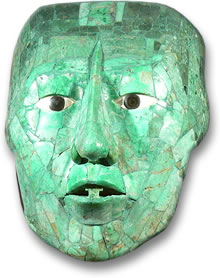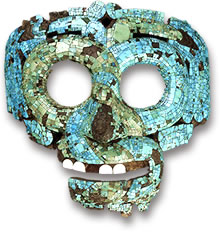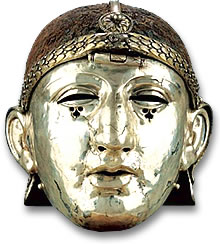|
|
Your Details
|
|
Your Details
|
Reviewed By Andreas Zabczyk
Precious Masks - Ancient Historic Rituals Jade Mask of Pacal the Great
Nowadays, a search for gemstone masks may come up with cosmetic treatments that contain minerals, or objects of art that are made from gemstone material. These are believed to make the wearer more beautiful. However, we refer to gemstone masks that have an intrinsic beauty; masks that have been made for thousands of years to cover the face for a variety of reasons. Some of the most astounding archaeological artifacts are masks. They may be made from pure gold, silver or colorful gemstone materials. These show that the artistry of ancient civilizations was relatively well developed. Ancient masks were mostly made for ritual or spiritual purposes rather than being purely for decoration. For example, funerary masks have been used by various cultures, such as the ancient Egyptians. One of the most famous death masks is that of King Tutankhamun, which was made of gold and inlaid with lapis lazuli, carnelian, and other gemstones. The ancient Egyptians believed that death masks would help to guide the spirit to its body in the afterlife. In other parts of Africa, masks resembling humans or animals have been used in various rituals, including those in which the spirit world is communicated with. Another famous funerary mask is a Greek Bronze Age mask known as the Mask of Agamemnon, which was discovered in Mycenae, southwest of the Greek capital city of Athens. This mask is constructed of one sheet of hammered and chased gold. The Mask was found covering the face of a corpse in a royal cemetery and was named by its discoverer after the Mycenaean king featured in historical literature by Homer. However, the mask dates back to around 300 years before the life of Agamemnon. More recently, in 1989, some ancient gold masks were found among artifacts in Kalmakareh Cave in Lorestan, Iran. These are dated to the Achaemenid Empire, also known as the First Persian Empire, founded by Cyrus the Great.  Ancient Mesoamerican Turquoise Mosaic Mask Replica
Some of the masks found from ancient Mesoamerican civilizations are incredibly colorful and beautiful works of art. One such example is the jade death mask of Mayan ruler, Janaab Pakal, (Pacal the Great), which was found on his remains, along with jade jewelry, including beaded necklaces, earrings, beaded bracelets and rings. The mask (see, top image) was made from jade mosaic with conch shell and obsidian inlay eyes. It is displayed in the National Museum of Anthropology, Mexico City, from where it was stolen by two thieves in 1984, and then recovered in 1989. Another stunning Mesoamerican gemstone mosaic mask is the turquoise mask of Xiuhtecuhtli, which is believed to be an image of a god. This beautiful piece of work is thought to have been used in religious ceremonies and may be seen at the British Museum in London. The Mesoamericans placed more value on turquoise than gold and silver, so it was used to construct precious, sacred objects. In many parts of the world, masks are used for theater and dance performances. For example, in ancient Greek theater, Chinese opera masks, Japanese Noh masks and Southeast Asian dance masks. These are often bright and colorful painted masks. Other colorful masks are used for festivals, such as Chinese New Year, when dragon masks are popular. One very colorful festival is the "Phi Ta Khon" Festival in Northern Thailand, also known as the Ghost Festival because the locals dress up, put on colorful ghost masks and parade through the town of Loei. While these masks are beautiful and bright, they do not usually contain any precious materials. Carnival masks that are sometimes encrusted with jewels and gold leaf are Venetian masks, which are a tradition of Venice Carnival. These were worn in order to hide social status so that all citizens were rendered equal.  Roman Silver Helmet & Face Mask
Protective helmets and masks have been an important aspect of battle armor since antiquity, and some of these have been constructed from precious materials. One such golden item is the helmet of King Meskalamdug, which was found among the Sumerian treasure of the Tombs at Ur. The Samurai wore face masks which featured fierce grimaces in addition to helmets. Some of these were colored with red or gold lacquer. Some Roman helmets with face masks were coated with silver or gold. These would have belonged to people of high social standing and may have been used for parades or worn in battle. Nowadays, masks are not so often used for religious purposes or in battle. However, some countries continue to use masks in their national dance, theater and festivals. Masks are intriguing artistic objects that reflect the history and culture of the region in which they are made. Indeed, masks are valued, collected and displayed by art lovers all over the world. |
